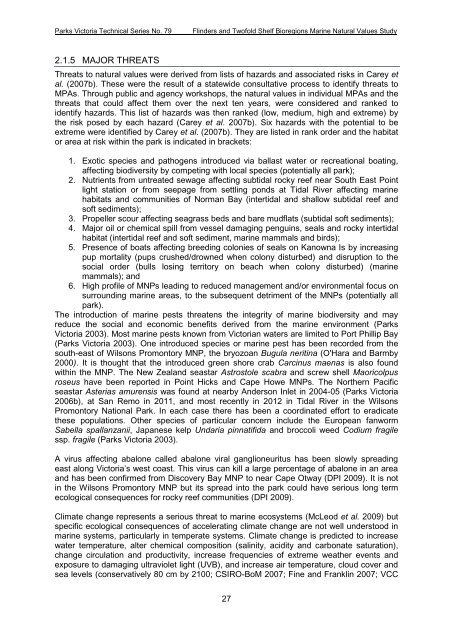parks victoria technical series marine natural values study vol 2 ...
parks victoria technical series marine natural values study vol 2 ...
parks victoria technical series marine natural values study vol 2 ...
Create successful ePaper yourself
Turn your PDF publications into a flip-book with our unique Google optimized e-Paper software.
Parks Victoria Technical Series No. 79<br />
Flinders and Twofold Shelf Bioregions Marine Natural Values Study<br />
2.1.5 MAJOR THREATS<br />
Threats to <strong>natural</strong> <strong>values</strong> were derived from lists of hazards and associated risks in Carey et<br />
al. (2007b). These were the result of a statewide consultative process to identify threats to<br />
MPAs. Through public and agency workshops, the <strong>natural</strong> <strong>values</strong> in individual MPAs and the<br />
threats that could affect them over the next ten years, were considered and ranked to<br />
identify hazards. This list of hazards was then ranked (low, medium, high and extreme) by<br />
the risk posed by each hazard (Carey et al. 2007b). Six hazards with the potential to be<br />
extreme were identified by Carey et al. (2007b). They are listed in rank order and the habitat<br />
or area at risk within the park is indicated in brackets:<br />
1. Exotic species and pathogens introduced via ballast water or recreational boating,<br />
affecting biodiversity by competing with local species (potentially all park);<br />
2. Nutrients from untreated sewage affecting subtidal rocky reef near South East Point<br />
light station or from seepage from settling ponds at Tidal River affecting <strong>marine</strong><br />
habitats and communities of Norman Bay (intertidal and shallow subtidal reef and<br />
soft sediments);<br />
3. Propeller scour affecting seagrass beds and bare mudflats (subtidal soft sediments);<br />
4. Major oil or chemical spill from vessel damaging penguins, seals and rocky intertidal<br />
habitat (intertidal reef and soft sediment, <strong>marine</strong> mammals and birds);<br />
5. Presence of boats affecting breeding colonies of seals on Kanowna Is by increasing<br />
pup mortality (pups crushed/drowned when colony disturbed) and disruption to the<br />
social order (bulls losing territory on beach when colony disturbed) (<strong>marine</strong><br />
mammals); and<br />
6. High profile of MNPs leading to reduced management and/or environmental focus on<br />
surrounding <strong>marine</strong> areas, to the subsequent detriment of the MNPs (potentially all<br />
park).<br />
The introduction of <strong>marine</strong> pests threatens the integrity of <strong>marine</strong> biodiversity and may<br />
reduce the social and economic benefits derived from the <strong>marine</strong> environment (Parks<br />
Victoria 2003). Most <strong>marine</strong> pests known from Victorian waters are limited to Port Phillip Bay<br />
(Parks Victoria 2003). One introduced species or <strong>marine</strong> pest has been recorded from the<br />
south-east of Wilsons Promontory MNP, the bryozoan Bugula neritina (O'Hara and Barmby<br />
2000). It is thought that the introduced green shore crab Carcinus maenas is also found<br />
within the MNP. The New Zealand seastar Astrostole scabra and screw shell Maoricolpus<br />
roseus have been reported in Point Hicks and Cape Howe MNPs. The Northern Pacific<br />
seastar Asterias amurensis was found at nearby Anderson Inlet in 2004-05 (Parks Victoria<br />
2006b), at San Remo in 2011, and most recently in 2012 in Tidal River in the Wilsons<br />
Promontory National Park. In each case there has been a coordinated effort to eradicate<br />
these populations. Other species of particular concern include the European fanworm<br />
Sabella spallanzanii, Japanese kelp Undaria pinnatifida and broccoli weed Codium fragile<br />
ssp. fragile (Parks Victoria 2003).<br />
A virus affecting abalone called abalone viral ganglioneuritus has been slowly spreading<br />
east along Victoria’s west coast. This virus can kill a large percentage of abalone in an area<br />
and has been confirmed from Discovery Bay MNP to near Cape Otway (DPI 2009). It is not<br />
in the Wilsons Promontory MNP but its spread into the park could have serious long term<br />
ecological consequences for rocky reef communities (DPI 2009).<br />
Climate change represents a serious threat to <strong>marine</strong> ecosystems (McLeod et al. 2009) but<br />
specific ecological consequences of accelerating climate change are not well understood in<br />
<strong>marine</strong> systems, particularly in temperate systems. Climate change is predicted to increase<br />
water temperature, alter chemical composition (salinity, acidity and carbonate saturation),<br />
change circulation and productivity, increase frequencies of extreme weather events and<br />
exposure to damaging ultraviolet light (UVB), and increase air temperature, cloud cover and<br />
sea levels (conservatively 80 cm by 2100; CSIRO-BoM 2007; Fine and Franklin 2007; VCC<br />
27

















